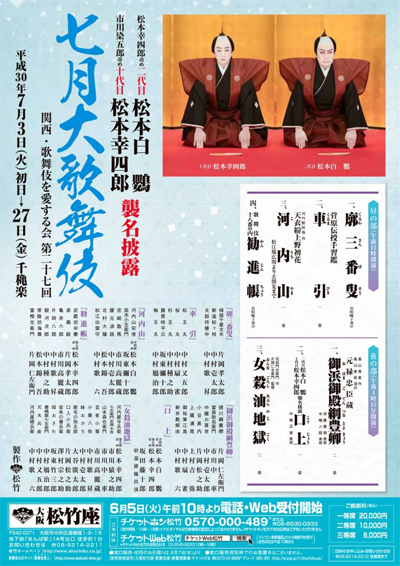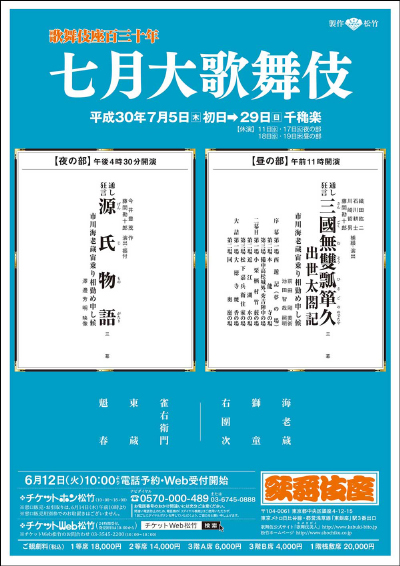| JULY 2018 |
|
2 in ďsaka (Sh˘chikuza), 3 shows in T˘ky˘ (Kabukiza, National Theatre) and 2 tours (Eastern Provinces, Central Provinces)!
|
| Sh˘chikuza (ďsaka) |  |
| Dates | 3 ~ 27 July 2018 Kansai Kabuki o Ai Suru Kai Shichigatsu ďkabuki The 27th Kansai Kabuki Lovers Society July Grand Kabuki |
| MatinÚe |
Sugawara Denju Tenarai Kagami (Kurumabiki) |
| Evening | |
| Casting |
Living National Treasure Sakata T˘jűr˘, Living National Treasure Kataoka Nizaemon, Matsumoto Haku˘, Matsumoto K˘shir˘, Nakamura Ganjir˘, Nakamura Senjaku, Ichikawa Ennosuke, Ichikawa Chűsha, Kataoka Takatar˘, Band˘ Yajűr˘, Band˘ Takesabur˘, Nakamura Karoku, Nakamura Matagor˘, Matsumoto Kingo, Nakamura Kazutar˘, Ichikawa Komaz˘, Sawamura S˘nosuke, Kamimura Kichiya, Nakamura Kash˘, Nakamura Tanenosuke, ďtani Hirotar˘, Kataoka Matsunosuke |
| Comments |
27th edition of the Kansai Kabuki Lovers Society July Grand Kabuki in ďsaka. Matsumoto Haku˘ II and his son Matsumoto K˘shir˘ X celebrate their shűmei in ďsaka at the Sh˘chikuza.
|
 |
| Kabukiza (T˘ky˘) |  |
| Dates | 5 ~ 29 July 2018 Shichigatsu Hanagata Kabuki July Young Actors Kabuki |
| MatinÚe |
Sangoku Mus˘ Hisago no Medetaya |
| Evening | |
| Casting |
Living National Treasure Nakamura T˘z˘, Ichikawa Ebiz˘, Nakamura Jakuemon, Nakamura Kaishun, Nakamura Shid˘, Ichikawa Udanji |
| Comments |
The usual July Grand Kabuki programs at the Kabukiza with a troupe led by Ichikawa Ebiz˘.
|
 |
| National Theatre (T˘ky˘) |
| Dates | 3 ~ 24 July 2018 Shichigatsu Kabuki Kansh˘ Ky˘shitsu July Kabuki Appreciation Class |
| Program | |
| Casting | |
| Comments |
Educational program at the National Theatre called Kabuki Kansh˘ Ky˘shitu ("Kabuki Appreciation Class"). This is a very interesting formula for the beginners because there is lively presentation of Kabuki (or some aspects of the art like music, stage tricks or fighting scenes) on stage, followed by a drama ("Furisode Hajime").
|
| Kabuki Tour in the central provinces | |
| Dates | 30 June ~ 29 July 2018 Sh˘chiku ďkabuki Sh˘chiku Grand Kabuki |
| Program | |
| Casting |
Nakamura Shikan, Nakamura Baigyoku, Kataoka Hidetar˘, Nakamura Hashinosuke, Nakamura Fukunosuke, Nakamura Kichinoj˘, Nakamura Baika |
| Comments |
The usual July Grand Kabuki Tour in the central provinces. Nakamura Shikan VIII and two of his three sons, Nakamura Hashinosuke IV and Nakamura Fukunosuke III, celebrate their shűmei.
|
| Kabuki Tour in the Eastern Provinces | |
| Dates | 30 June ~ 31 July 2018 Sh˘chiku ďkabuki Sh˘chiku Grand Kabuki |
| Program | |
| Casting |
Onoe Kikunosuke, Ichikawa Danz˘, Band˘ Hikosabur˘, Nakamura Baishi, Nakamura Yonekichi, Nakamura Mantar˘, Ichimura Kitsutar˘ |
| Comments |
The usual July Grand Kabuki Tour in the Eastern Provinces.
|
|
|
| Contact | Main | Top | Updates | Actors | Plays | Playwrights | Programs | Links | FAQ | Glossary | Chronology | Illustrations | Prints | Characters | Derivatives | Theaters | Coming soon | News |